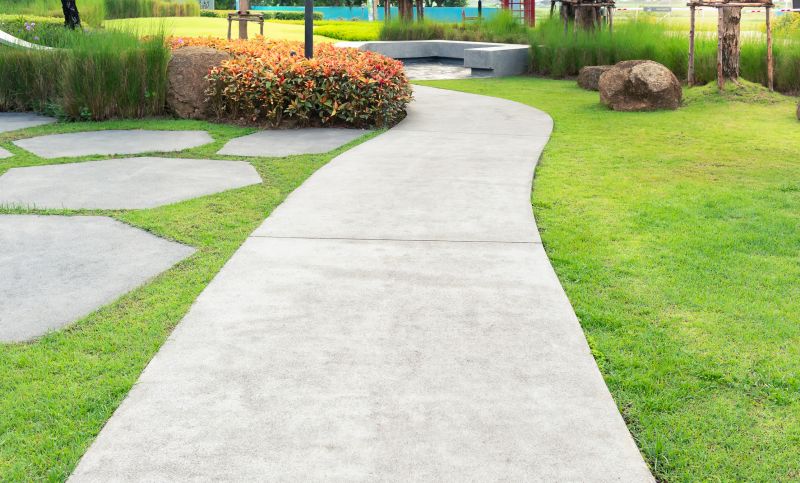Top Products For Concrete Resurfacing Service Options
Discover the most effective tools and materials to achieve a smooth, durable finish for your concrete surfaces with ease.
 Concrete resurfacing products are essential for revitalizing and restoring the appearance of worn or damaged concrete surfaces. These products typically include overlays, coatings, and sealers designed to adhere to existing concrete, providing a fresh, uniform look while offering protection against future wear and tear. When selecting resurfacing solutions, it's important to consider the specific condition of the concrete, the desired finish, and the environment where the surface is located. Some products are formulated for indoor use, such as basement floors or garage interiors, while others are suitable for outdoor applications like driveways, patios, and walkways.
Concrete resurfacing products are essential for revitalizing and restoring the appearance of worn or damaged concrete surfaces. These products typically include overlays, coatings, and sealers designed to adhere to existing concrete, providing a fresh, uniform look while offering protection against future wear and tear. When selecting resurfacing solutions, it's important to consider the specific condition of the concrete, the desired finish, and the environment where the surface is located. Some products are formulated for indoor use, such as basement floors or garage interiors, while others are suitable for outdoor applications like driveways, patios, and walkways.
Top Overall Option
Polymer-Modified Concrete Overlay
A versatile polymer-modified overlay offers a durable and flexible surface that adheres well to existing concrete. Its formulation allows for a range of finishes, from smooth to textured, making it suitable for various applications. This type of product is appreciated for its ease of application, strong bonding properties, and ability to conceal imperfections. Ideal for both residential and commercial projects, it provides a long-lasting surface that can be customized to match aesthetic preferences.
Types of Products For Concrete Resurfacing Service
Acrylic Concrete Coatings
Water-based coatings that provide a smooth, glossy finish suitable for indoor and outdoor surfaces.
Epoxy Floor Coatings
Highly durable coatings often used in garages and industrial spaces for resistance to chemicals and wear.
Polyurethane Coatings
Flexible coatings that offer UV resistance and a glossy finish, ideal for outdoor applications.
Stamped Overlays
Decorative overlays that mimic stone, brick, or tile patterns, adding aesthetic appeal.
Polymer-Modified Cement
Enhanced cement mixes that provide improved adhesion and flexibility for resurfacing.
Self-Leveling Overlays
Products designed to create a flat, smooth surface over uneven concrete.
Sealants and Topcoats
Protective layers that seal the surface and enhance durability and appearance.
Concrete Repair Mortars
Used to fill cracks and repair damaged areas before applying resurfacing products.
Decorative Stains
Coloring agents that add vibrant hues and patterns to concrete surfaces.
Textured Coatings
Products that provide slip-resistant textures for safety and aesthetic purposes.
Liquid Concrete Resurfacer
Thin-layer coatings that restore the surface and prepare it for further finishing.
Polyurea Coatings
Fast-curing and highly flexible coatings suitable for high-traffic areas.
Popular Choices
Widely used for their ease of application and variety of finishes, suitable for many surfaces.
Favored for their durability and resistance properties, especially in garages and commercial spaces.
Popular for decorative purposes, offering a variety of patterns and textures.
Commonly chosen for outdoor surfaces due to their UV resistance and gloss retention.
Ideal for creating smooth surfaces over uneven concrete slabs.
Used to add color and artistic effects to existing concrete surfaces.
Popular for quick restoration of worn surfaces with a thin, even layer.
Chosen for their rapid curing times and high flexibility in demanding environments.
Selected for safety in outdoor walkways, pool decks, and patios.
Frequently used to fix cracks and chips before applying resurfacing products.
Resurfacing products come in various forms, including acrylic overlays, polymer-modified cements, epoxy coatings, and decorative stamped overlays. Each type offers different aesthetic and functional benefits, from smooth, glossy finishes to textured, slip-resistant surfaces. Proper surface preparation is crucial for achieving optimal adhesion and durability, which often involves cleaning, repairing cracks, and sometimes etching the existing concrete. Many products include additives or primers to enhance bonding and longevity.
Choosing the right product also involves considering application methods, drying and curing times, and maintenance requirements. Some products are designed for DIY application with straightforward mixing and spreading, while others may require professional installation. Regular maintenance, such as resealing or cleaning, can extend the lifespan of the resurfaced concrete and keep it looking its best. With a wide array of options available, homeowners and contractors can find suitable solutions for nearly any concrete resurfacing project, whether for aesthetic upgrades or functional improvements.
Key Buying Considerations
- Determine the specific condition of the existing concrete surface, including cracks, spalling, or unevenness.
- Identify whether the project is indoor or outdoor, as some products are better suited for certain environments.
- Consider the desired finish, such as glossy, matte, textured, or stamped patterns.
- Check the compatibility of the product with existing surfaces and materials.
- Evaluate the ease of application, especially if planning a DIY project, versus professional installation requirements.
- Review drying and curing times to plan project timelines accordingly.
- Assess the slip resistance and safety features, particularly for outdoor or high-traffic areas.
- Look into maintenance requirements and how often resealing or reapplication might be needed.
- Consider environmental conditions like UV exposure, moisture, and temperature fluctuations.
- Verify the adhesion qualities and whether primers or surface preparation are necessary.
- Examine the product’s flexibility and crack-bridging capabilities for surfaces prone to movement.
- Review product durability and resistance to chemicals, stains, and wear.
- Determine the budget and compare cost versus longevity and performance.
- Ensure proper surface preparation tools are available, such as cleaning equipment and repair materials.
- Check for compatibility with decorative elements like stains or embedded patterns.
